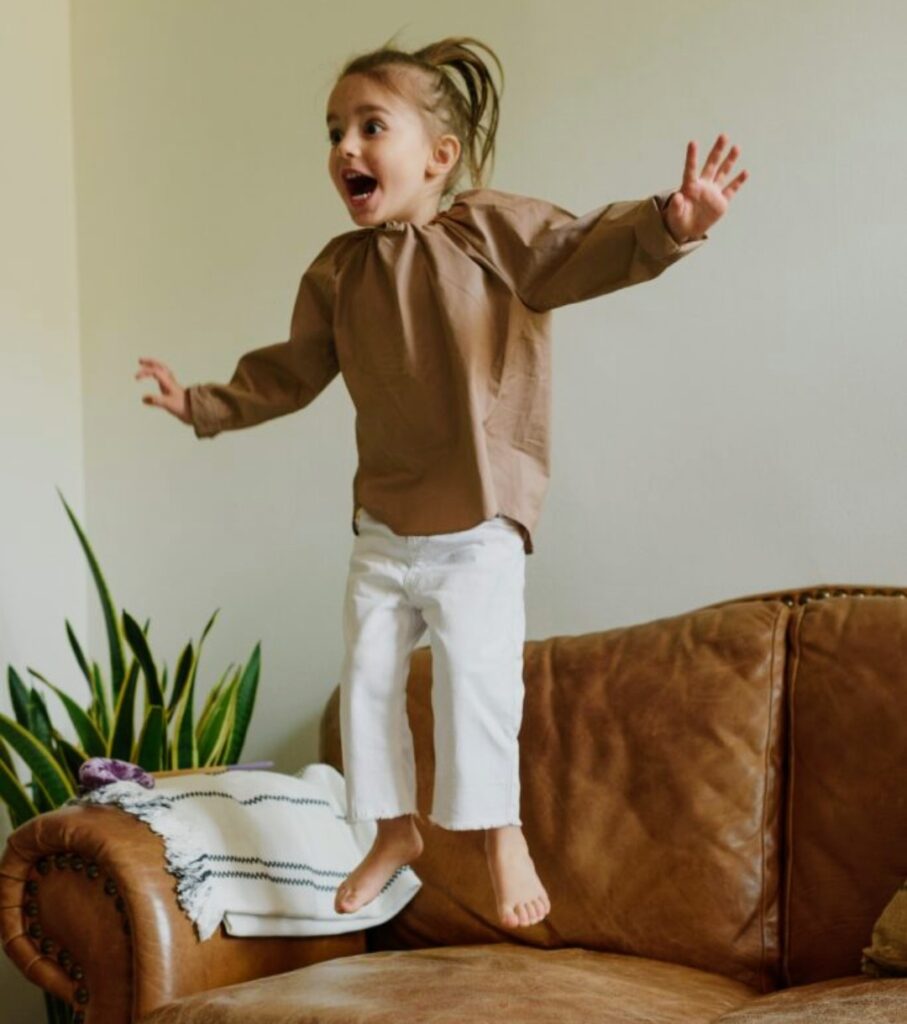Having a child with ASD can lead to some difficult situations such as an autistic child jumping on the furniture.
In this article, we’ll delve into the reasons behind this behaviour and explore strategies for gradually moving them away from this activity.
Autism and jumping on furniture
We all know that autistic children can develop any number of quirky behaviours.
One of the behaviours that parents might notice is their autistic child’s fondness for jumping on furniture.
While this might seem unconventional to some, it’s important to recognise that this behavior serves a purpose in the child’s world.

A sensory experience
Autistic children often experience the world through their senses in a heightened and sometimes different way than neurotypical peers.
Furniture jumping can be a way for them to seek sensory input and regulate their emotions.
The impact of the physical sensation of jumping can provide comfort and stimulation that helps them manage sensory overload, anxiety, or stress.
Movement can be an itch that an autistic child just has to scratch, and jumping is manifestation of that need.
This can be in the same way how some autistic children struggle to sit still for long periods.
Just as jumping up and down can feel pleasurable, sitting still can feel uncomfortable.
As an aside, if this is the case with your child you could try a wiggle cushion on occasions such as meal times.
Good old fun
Jumping on furniture might also be a form of self-expression for autistic children.
The sheer act of bouncing allows them to release pent-up energy and express their emotions in a way that feels liberating and enjoyable.
It’s a moment of pure joy and freedom that can be hard for others to comprehend without understanding the child’s unique perspective.
Routine or habit
Whilst there are likely sensory reasons for a child jumping on furniture, a fondness for routine is also likely a factor.
Autistic children often find comfort in activities they are familiar with. These activities don’t present any unexpected surprises or requirements from them.
So it may well be that an autistic child has tried jumping once or twice and formed a routine that provides them structure and comfort.
Difficulty with other activities
Autistic children may struggle with social interactions and communication.
Due to this they may struggle with traditional past times such as games with siblings or friends.
If this is the case then it is almost understandable that they find comfort in a form of entertainment which asks for nothing in return.
It is a solo, enjoyable activity which provides sensory feedback after all.
Not all bad
Whilst it is clear there are negatives to this behaviour such as risk of injury or damage to furniture, there are positives.
For many autistic children, developing coordination and body awareness can be a challenge.
Jumping on furniture can serve as a form of physical therapy, helping them improve balance, muscle strength, and body awareness.
It’s a way for them to learn about their body and the space around them through movement.
Also you have the obvious point that it is a form of quite intensive exercise which has multiple benefits.
How to stop an autistic child jumping on the furniture
While it’s important to recognise the reasons behind furniture jumping, it’s equally crucial to provide alternatives that are safe and appropriate.
Here are some strategies to consider:
Provide an alternative
Feel free to file this suggestion as stating the obvious but providing an alternative is probably the quickest solution.
Create a designated space where your child can safely engage in jumping activities.
A number of parents in this position swear by trampolines and they are also a tactic employed by special needs schools.
They are a cheap and effective way of allowing a child to fulfill their needs without risking damage or injury.
Sensory play
Introduce other sensory activities that can help your child regulate their emotions and engage their senses.
This could include activities like swinging, rocking, or playing with sensory toys.
Whilst these activities are different from jumping, they still may be able to scratch the sensory itch which is leading to the behaviour.
Offer choice in activities
If you feel like your child is about to start jumping on furniture, have some other activities lined up.
Encourage your child to communicate their feelings and preferences.
Give them a choice between different activities, allowing them to have some control over their sensory experiences.
Depending on your child’s level of communication you can use pictures to help them choose an activity.
Make physical changes
One of the more drastic measures to consider would be to make physical changes to your furniture.
If for example your child likes to jump on a sofa you could try changing its location or even swapping it all together.
We appreciate that sofas are expensive but if you were to swap it for one which doesn’t bounce then that could put an end to the behaviour.
Use timers and countdowns
If you have tried all other means and your child still insists on jumping then you can try to reduce the behaviour.
Use visual timers to set limits for jumping time.
This can help your child understand when it’s time to transition to a different activity and reduce potential meltdowns.
Summary – Autistic child jumping on furniture?
Understanding your autistic child’s need for furniture jumping requires empathy, patience, and a willingness to see the world from their perspective.
This behaviour serves as a way for them to navigate their sensory experiences, express themselves, and develop physical skills.
By creating a safe environment that acknowledges their needs while gently redirecting their behaviours is key.
With alternatives, distractions and time you should be able to divert your child from jumping on furniture.

